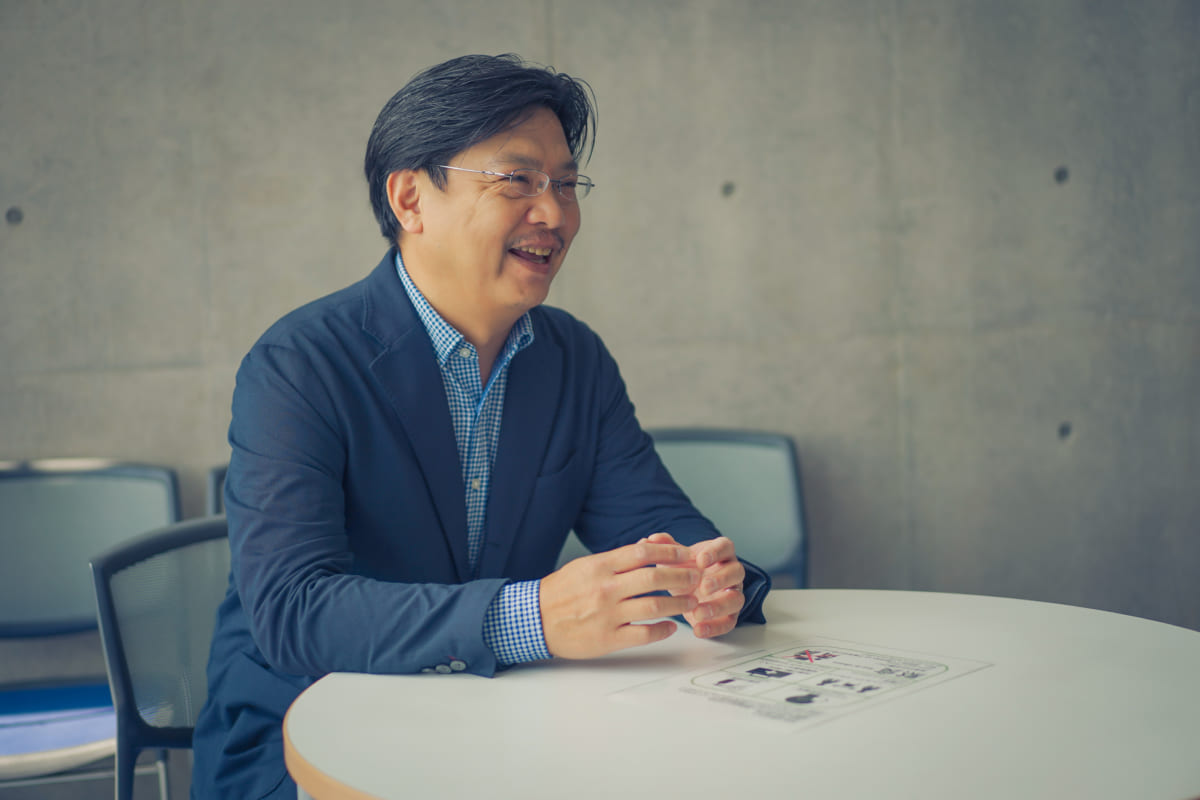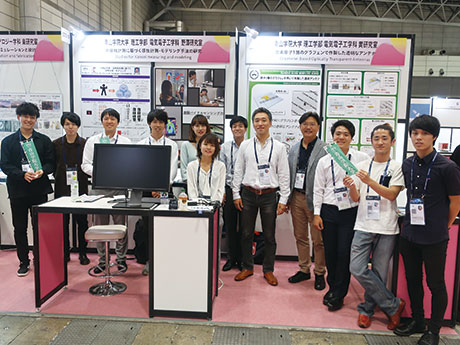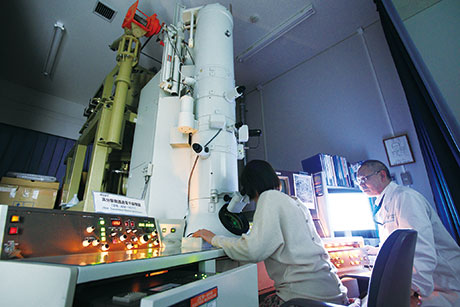- Home RESEARCHResearch Highlights
- On the Front Lines of Research at Aoyama Gakuin University
On the Front Lines of Research at Aoyama Gakuin University
- MENU -
Aoyama Gakuin University: A School Attracting Attention for its Research Prowess
Aoyama Gakuin University has also made spectacular breakthroughs in research undertaken at its College of Science and Engineering. In the May 2021 issue of the science magazine Newton, the university was assessed highly in ranking of science and engineering universities. AGU also clinched the number one spot ahead of other schools in the “MARCH” group of private universities when it came to a ranked list concerning job placement rates for students at 400 famous companies and a ranked list concerning university research prowess in the field of cosmic science. We asked Professor Shinji Koh, Advisor to the President and Head of Industry-Academia-Government Collaboration, about elements such as initiatives aimed at further facilitating the nurturing of brilliant students and progress in terms of practical research, along with the establishment and maintenance of environments serving to those ends.

Shinji Koh
Professor at the College of Science and Engineering, Department of Electrical Engineering and Electronics // Advisor to the President // Head of Industry-Academia-Government Collaboration
Shinji Koh finished a doctorate program at the Department of Applied Physics, Graduate School of Engineering, the University of Tokyo in 2000. Has a PhD in Engineering from the University of Tokyo. After working as a Research Assistant at the University of Tokyo, as a Research Assistant at Tohoku University, and as a Associate Professor at the Nara Institute of Science and Technology, Shinji took the position of Associate Professor in 2013 at the College of Science and Engineering in the Department of Electrical Engineering and Electronics at Aoyama Gakuin University. In 2018, he became a Professor. He is Director of the Institute of Nano-Carbon Device Technology, Director of the Aoyama Gakuin University Project Research Institute, and Vice Director of the Aoyama Gakuin University Liaison Center. His specializations are crystal growth for functional materials, evaluations of physical properties, and device applications. Professor Koh officially began his research concerning the crystal growth of graphene (which is a sheet-shaped material comprised of carbon atoms) and device applications at Aoyama Gakuin University. He is currently working on research and development in areas such as thermal chemical vapor deposition (CVD) of iridium single crystal graphene, graphene-based transparent antennas, and electrochemical devices with graphene. He belongs to academic societies such as the Japan Society of Applied Physics, the Electrochemical Society of Japan, and the Japan New Diamond Forum.

Aoyama Gakuin University Project Research Institute - Adding vitality to research through flexible management -
In 2018, Professor Osamu Hashimoto (Department of Electrical Engineering and Electronics, College of Science and Engineering), who was the university’s Vice President at the time, took the lead in establishing the Integrated Research Organization, the head of which is the university’s President. The Aoyama Gakuin University Project Research Institute (“AGU Project Research Institute”) was established and formed one of the two pillars of the organization, with the other being the historic Aoyama Gakuin University Research Institute. Professor Hashimoto is Director of the Institute of Electromagnetic Compatibility and I am Director of the Institute of Nano-Carbon Device Technology. Both of these organizations belong to the AGU Project Research Institute. The Aoyama Gakuin University Research Institute is run using on-campus funding. The AGU Project Research Institute, however, uses externally-sourced funding comprised of medium and large amounts. The organization’s system works in a way which allows faculty staff who have acquired external funding to set up externally-funded project research labs that are respectively named in accordance with the content of the research being undertaken. The AGU Project Research Institute provides budget support in conjunction with that. Moreover, even without a degree, it is possible for visiting researchers and research fellows to be appointed to a position at the AGU Project Research Institute based on an assessment of their practical business achievements. And, the organization is designed so that a wide variety of talent can participate in research projects, including researchers belonging to external research organizations. The purpose behind having deployed this new, flexible program which provides high levels of freedom both in terms of funds and talent, is to facilitate the further vitalization of our research.
We have been publishing a pamphlet called the AGU RESEARCH REPORT, which introduces readers to the overall research activities being conducted by our university, including details on research being undertaken at each research lab since fiscal 2018, when the Integrated Research Organization was established. We have many faculty members at our university who are conducting top-level research on the world stage. We began producing this pamphlet with the aspiration of sparking new endeavors by having people on our campus learn about what kind of research is going on at other labs. At my research lab, we are conducting multiple joint research projects in cooperation with Professor Hashimoto’s research lab, which we have been doing since 2014. One recent project among those was one where we succeeded in making highly-efficient, optically transparent antenna based on carrier-doped three-layer stacked graphene. The paper was published in an overseas academic journal and has received high praise. We succeeded in achieving high efficiency by preparing a transparent antenna using graphene, an extremely thin carbon material. This spring, the student who conducted this research finished his doctoral program and went on to get a research position at a large communications company. We have great expectations for his success going forward.

Liaison Center - Serving as a bridge between industry, government and academia -
Since 2018, I have been promoting the vitalization of research as the Director of the AGU Project Research Institute. I have also been working on coordination between industry, government and academic within the frameworks of liaison projects since 2017 as the staff leader. In 2017, after welcoming Yuji Baba as the URA (University Research Administrator) dealing exclusively with liaison projects, we have been undertaking initiatives with the goal of getting more people to learn about the research being done at Aoyama Gakuin University, with one such initiative being the solo holding of Aoyama Gakuin University’s first JST New Technology Presentation Meeting. We have been proactively building relationships with external entities through efforts such as the implementation of “Meet up in AGU” (an event for collaboration between industry and academia) and the holding of events in collaboration with the Nansei Forum, a consortium for corporations in the region. During the fiscal 2018 and 2019 period, we took part in “Innovation JAPAN (University Trade Fair and Business Matching)” which turned out to be one of the largest university trade fairs and business matching events in the country. In 2019, we participated as an exhibitor for Co-Creation PARK as part of CEATEC 2019, an international exhibition in the fields of CPS (Cyber Physical Systems and the IoT (Internet of Things)).
As the staff leader of liaison projects, I have had us exhibit technology seeds such as graphene transparent antennas at various exhibitions, upon which we received inquiries from tens of companies. We have actually been moving forward with joint research together with several companies, so I feel that the response to our efforts has been significant. The Liaison Project was originally a single-year project. But in 2019, we set up the Liaison Center as a permanent body at the Integrated Research Organization. Through the efforts of our Liaison Center, we want to get people outside of the university to learn about as many as possible of the research projects and technologies worked on by our faculty members and increase opportunities for joint research with corporations. As the Advisor to the President, I will continue to promote initiatives at the Project Research Institute and the Liaison Center and want to deploy new ideas to contribute to the vitalization of research activities undertaken at our university.


Enhancement of research environments and measures for student support at the College of Science and Engineering
There are five entities attached to the College of Science and Engineering, which are the Center for Instrumental Analysis, the Center for Advanced Technology (CAT), the Center for Advanced Information Technology Research, the Isotope Experiment Center, and the Machine Workshop. For instance, the Center for Instrumental Analysis, which conducts the centralized management of large analysis instruments, is shared by various research labs. The students at my research lab also use that facility often. In addition to these enhancements to our research environments, we have also been putting energy into initiatives which serve to boost the number of people going to graduate school. At the College of Science and Engineering, we have increased the number of students in our undergraduate programs moving on to our master’s programs from the top 50% to the top 65%. Top-performing students going into a program at the Graduate School of Science and Engineering are provided with tuition exemptions (for either half or the full amount of tuition) in order to decrease the number of cases where top-performing students end up giving up on going to graduate school due to their financial situation. In the doctoral program, a virtually complete exemption of tuition is applied thanks to the AGU Scholarship for the Nurturing of Young Researchers.
Thanks to mechanisms like these, the rate of students going on to graduate school has been increasing steadily in recent years, and we have also seen increases in the number of female students entering the College of Science and Engineering. Women in particular may have to deal with difficult hurdles due to leaving their job as a result of a birth, to raise their children, or due to another such event and subsequently find it difficult to re-enter the workforce afterwards. By acquiring a specialization, women can find it much easier to rejoin the workforce. If I were to speak in terms of my own field of specialization, automobiles are going to be making a shift to electricity in the future. While it goes without saying that electricity is indispensable for communications, this is also the case for other areas of our lives, such as medicine and welfare. There is certainly demand, which will no doubt increase going forward. So regardless of whether someone is male or female, acquiring a specialization and working on high-level research allows one to polish their own human qualities and grow as a person. The acquisition of a master’s degree or a PhD will serve as a great weapon to have in one’s life. Students can acquire specializations in various fields at our College of Science and Engineering. We would love to see more people take on the challenge of doing research there.

Programs serving to support the activities such as research activities conducted at graduate school
◆Scholarship for the Nurturing of Young Researchers
All tuition is waived for the standard period of study in a doctoral program or for years three, four and five (three-year period) of a combined master's and doctoral program.
This is our own grant-type scholarship which provides brilliant young talent with support for their studies. The goal of this is to add vitality to our graduate school and to nurture young researchers who will contribute to society after we equip them with sophisticated specializations and research abilities. Eligible students are those who are under the age of thirty when enrolling and who have made it through the scholarship’s selection process.
◆Support Program for Presentations at International Academic Conferences
This program provides a maximum of 70,000 yen for participation in domestic academic conferences and a maximum of 150,000 yen for participation in academic conferences abroad.
With the purpose of supporting global education and nurturing young researchers, we provide support for some or all of the expenses involved in research presentations (including travel costs) given by graduate school students at international academic conferences held in Japan and abroad.
◆Early Eagle Research Support Program
This program is available to doctoral program students. *There are also separate support programs available for Research Assistants and Associate Professors.
Support amount: 250,000 yen
This program applies to projects conducted by young researchers (doctoral program students) involving creative and trailblazing research and projects which are expected to develop into such. After students enter a doctoral program, a screening process takes place during the first half of the year and around twelve projects are provided with support.
◆Graduate Assistant Program
In fiscal 2020, we launched a new program which involves the hiring of graduate school students as graduate assistants. Eligible students are those in a doctoral program or those who are in at least the third year of their combined master's and doctoral program. The program involves graduate students at our university being hired as graduate assistants. While maintaining a priority on their research, they conduct sophisticated assistant work, such as giving lectures to undergraduate students, running lab courses, and the running of international conferences. By creating places where students can build practical experience as assistants and making sure they have financial support, we provide research environments where these graduate students can concentrate on their research, with the purpose being to assist them in improving upon on their abilities as researchers.